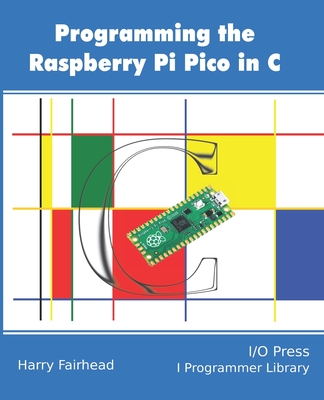Programming The Raspberry Pi Pico In C

Programming The Raspberry Pi Pico In C
There is a new edition of this book: Programming The Raspberry Pi Pico/W In C, Second Edition
The Raspberry Pi Pico is a remarkable microcontroller. It has a power and sophistication that would have been unthinkable just a short time ago. For the sort of jobs it is ideal for, it has plenty of processing power and enough memory to make tasks that would have once required careful planning, relatively easy. Instead of struggling with the machine, you can now focus on getting a good implementation of your algorithms. To enjoy all of its power and sophistication there is no better language than C. It wastes none of the power and it gives you what you need to get at the new features. However, getting started with the Pico with C is no easy feat, which is what motivated this book about creating programs so that testing and debugging is easy.Programming the Raspberry Pi Pico in C uses the highly popular VS Code as its development environment and shows how to use a Raspberry Pi or a desktop PC running Windows as your development machine. The purpose of the book is to reveal what you can do with the Pico's GPIO lines together with widely used sensors, servos and motors and ADCs. After covering the GPIO, outputs and inputs, events and interrupts, it gives you hands-on experience of PWM (Pulse Width Modulation), the SPI bus, the I2C bus and the 1-Wire bus.
One of the key advantages of the Pico is its PIO (Programmable I/O) and while this is an advanced feature it is included in this book. After finding out how the PIO works, we apply it to writing a PIO program for the DHT22 and the 1-Wire bus. One current drawback of the Pico it is that it doesn't have a network connection. To solve this problem there is a chapter on using the low-cost ESP8266 as a WiFi client and web server. The two devices together make the Pico a true IoT device.
Harry Fairhead has a hardware background and, having worked with microprocessors and electronics in general, for many years, he is an enthusiastic proponent of the IoT and embedded computing. He is the author of two books intended for C programmers, Fundamental C: Getting Closer To The Machine and Applying C For the IoT With Linux and four books on the using the Raspberry Pi in an IoT context, two using C and two using Python. He is now working on a Python version of this book for the Pico.
309.92Lei
309.92Lei
Indisponibil
Descrierea produsului
There is a new edition of this book: Programming The Raspberry Pi Pico/W In C, Second Edition
The Raspberry Pi Pico is a remarkable microcontroller. It has a power and sophistication that would have been unthinkable just a short time ago. For the sort of jobs it is ideal for, it has plenty of processing power and enough memory to make tasks that would have once required careful planning, relatively easy. Instead of struggling with the machine, you can now focus on getting a good implementation of your algorithms. To enjoy all of its power and sophistication there is no better language than C. It wastes none of the power and it gives you what you need to get at the new features. However, getting started with the Pico with C is no easy feat, which is what motivated this book about creating programs so that testing and debugging is easy.Programming the Raspberry Pi Pico in C uses the highly popular VS Code as its development environment and shows how to use a Raspberry Pi or a desktop PC running Windows as your development machine. The purpose of the book is to reveal what you can do with the Pico's GPIO lines together with widely used sensors, servos and motors and ADCs. After covering the GPIO, outputs and inputs, events and interrupts, it gives you hands-on experience of PWM (Pulse Width Modulation), the SPI bus, the I2C bus and the 1-Wire bus.
One of the key advantages of the Pico is its PIO (Programmable I/O) and while this is an advanced feature it is included in this book. After finding out how the PIO works, we apply it to writing a PIO program for the DHT22 and the 1-Wire bus. One current drawback of the Pico it is that it doesn't have a network connection. To solve this problem there is a chapter on using the low-cost ESP8266 as a WiFi client and web server. The two devices together make the Pico a true IoT device.
Harry Fairhead has a hardware background and, having worked with microprocessors and electronics in general, for many years, he is an enthusiastic proponent of the IoT and embedded computing. He is the author of two books intended for C programmers, Fundamental C: Getting Closer To The Machine and Applying C For the IoT With Linux and four books on the using the Raspberry Pi in an IoT context, two using C and two using Python. He is now working on a Python version of this book for the Pico.
Detaliile produsului










